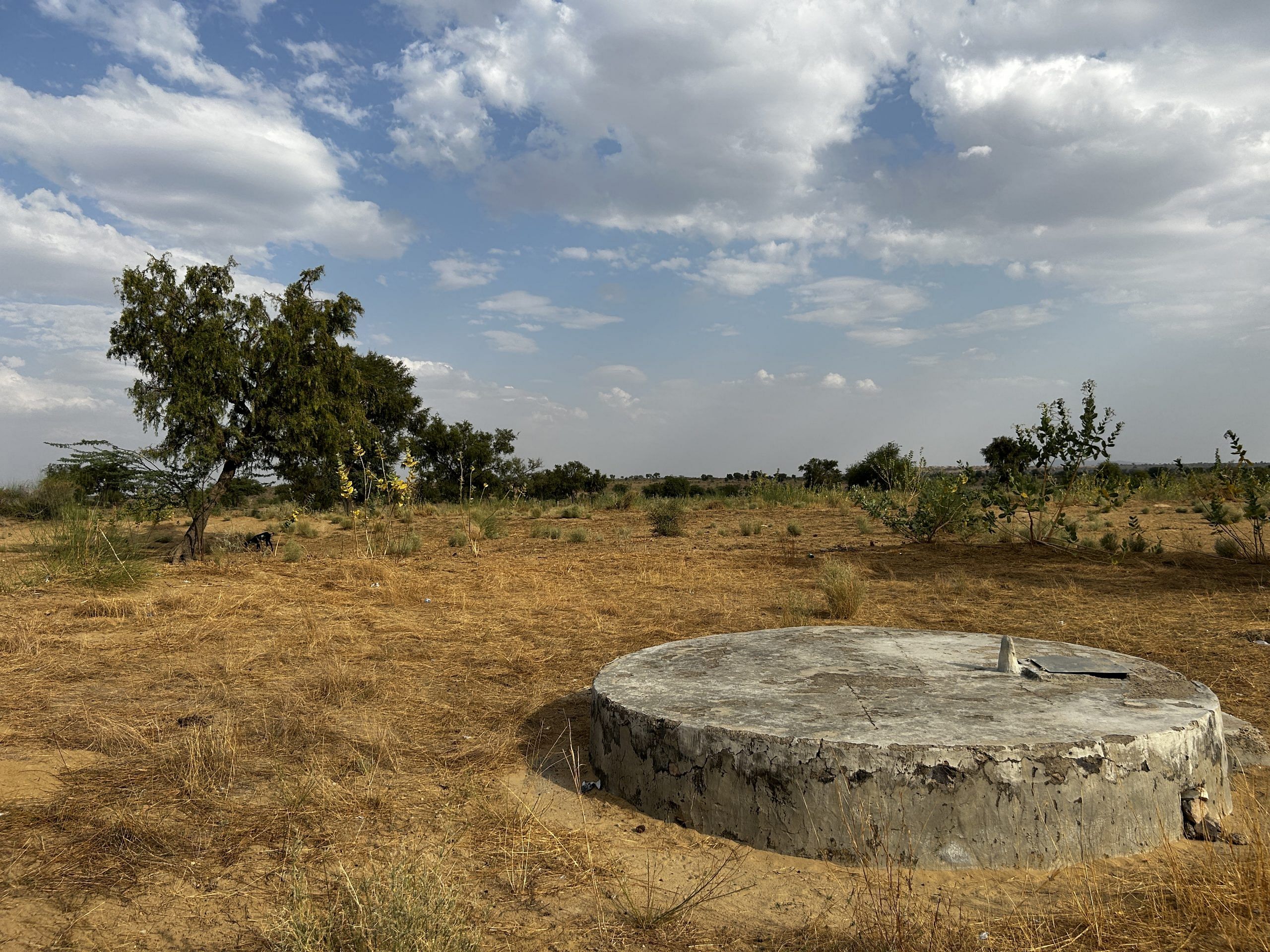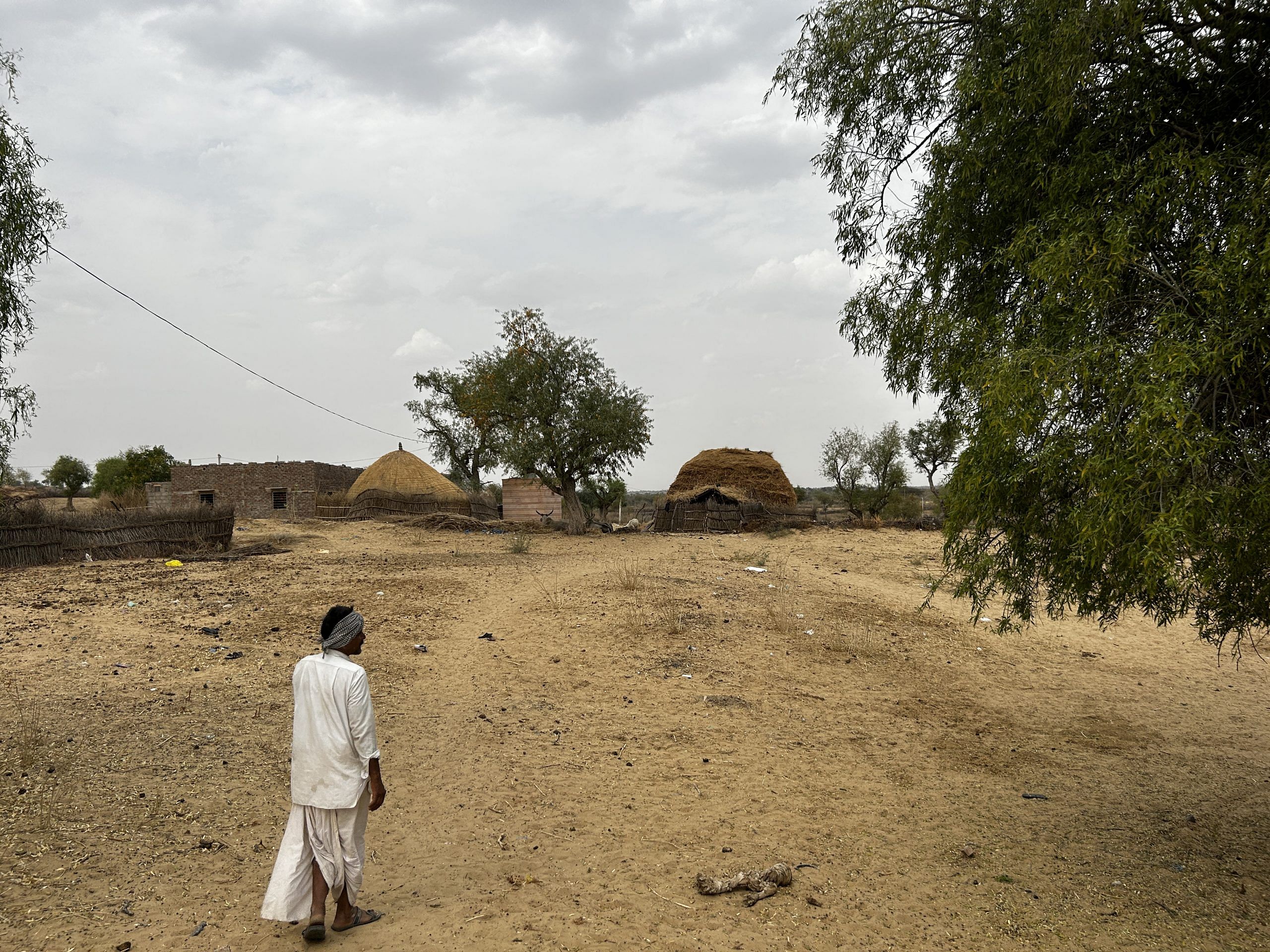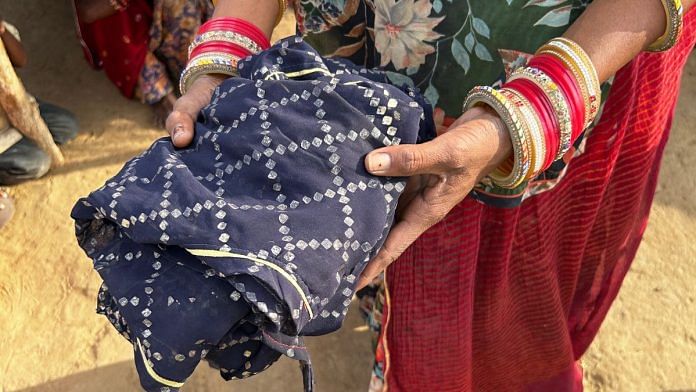Barmer: Hanuman Ram, 27, woke up at 5 am and realised his 20-year-old wife Mamta was missing. Dawn had broken in Barmer district. Alarmed, he alerted the villagers and began to follow her footprints in the sand. They led him to a nearby well. He did not want to see what lay beyond. Hanuman Ram knew where his wife was.
Barmer is known for oil, coal, and gas. But this second largest desert district in Rajasthan, along the India-Pakistan border, is battling a strange outbreak — suicide among its young married women. They are jumping into wells or tankas. And many are taking their toddlers with them. District officials estimate that around 50 cases in the last five years involved children.
While the absolute number of suicides is higher for men, the ratio of women dying by suicide in Barmer (37 to 63) is higher than the national average (27.4 to 72.5), said district officials. And they’re going to the well. Officials, local Hindi media, and police are paying attention. But the flip side is that this all-round focus is resulting in copycat suicides.
The 12X10 feet deep well that Mamta chose on the morning of 9 April had been sealed shut by the administration two years ago, in a desperate effort to reduce the number of young women dying by suicide. However, a small hole, just big enough for Mamta to squeeze through, had been left open. It took two hours to retrieve her corpse.

The ‘suicide contagion’, which has been on the rise since 2019, has everyone in Barmer on edge.
“They were jumping to death in their first attempt,” said District Magistrate Lok Bandhu, who was posted to Barmer in April 2021, right in the midst of the second wave of Covid. He found himself battling a deadly viral pandemic and an equally deadly epidemic.
Desperate measures
The IAS officer was worried not just because young women were dying but because of how they were dying. Barmer reported 48 women suicide cases in 2019, 54 in 2020, and 64 in 2021.
“At least 60 per cent of suicides were ‘well deaths,” said Bandhu. The administration launched the Anmol Jeevan (precious life) campaign on 10 October 2021, on World Mental Health Day. A 24-hour helpline was set up; village officials were taught to identify warning signs; gram panchayats were asked to cover the wells with concrete; and YouTubers were urged not to sensationalise the deaths.
There was an immediate result. The helpline started receiving around 15 to 20 calls every month. Not just women but men and sometimes even children called for help. In 2022, the number of reported suicides of women had come down to 37—a decline of 42 per cent, according to district administration data.
Such drastic and contentious measures are not unusual in India when copycat suicides take place. The administration at the Indian Institute of Science (IISc) in Bengaluru replaced ceiling fans in hostel rooms with wall-mounted fans after four students allegedly died by suicide between January and March 2021. Delhi Metro Rail Corporation (DMRC) installed platform screen doors in several stations after 25 people attempted suicide by jumping on the tracks between January 2018 and May 2019.
In North Delhi, the police want the tourism department to put up mesh walls to prevent people from jumping from the 154-metre signature bridge into the Yamuna river below. On average, three people are rescued from the bridge every month, and in the last year and a half, private divers have saved around 30 people who had jumped into the river.
In Barmer, it’s the wells that are becoming the focal point. They were sealed with concrete and hand pumps were installed in as many as 600 of them.

These wells are different from the community village wells seen in other parts of India. The tankas, or man-made water storage tanks, are built in the family’s private spaces. And many a time, that’s really how far rural societies allow veiled women to go. Their restricted mobility is what tethers them to these wells.
“When a person thinks of suicide, he or she finds the most familiar place or object for self-harm. Women in Barmer are familiar with wells,” said Dr Lakshmi Vijayakumar, head of the psychiatry department, Voluntary Health Services, Chennai.
A district-wide survey by village heads and teachers listed inter-caste and extra-marital affairs, child marriages, harassment by in-laws, and domestic violence as some of the reasons for this wave of copycat suicides. Dowry, drought and debt were also contributing factors. Vijayakumar adds one more—sensationalisation by the media without providing helpline numbers or stories of hope.
“Such news triggers the vulnerable individuals who are stuck in similar situations,” she said.
But the Anmol Jeevan initiative, which saw a measure of success, was halted in October 2022. Now, death by suicide in Barmer is on the rise again.
Trapped and released by the well
Mamta grew up in Kagau village, not far from Barmer. In 2020, her parents married her off to Hanuman, a daily wage worker from the Bheel community in Rawatoniyo Ki Dhani village in Chadar panchayat.
“She wasn’t happy here. The couple often fought,” said Durga Ram Godara, son of the former village head of Chadar panchayat.
He says they have had more than five copycat suicides in five years in Chadar panchayat alone. “They all jumped into the well. This is where our women spend most of their time—fetching water. This is where their lives are trapped,” he said.
Mamta’s family doesn’t have her Aadhaar card or any certificate—she never went to school. They don’t have a photograph of the wedding ceremony either. It was a lockdown wedding. A shiny black dress, hair oil and a moisturiser are all that’s left of her belongings.
Jumping into the well was her second attempt at suicide.
“[The first time] she tried to hang herself from a Khejri tree; the rope broke and she fell,” said Hanuman, who tells everyone that he is innocent, and that he had no role in his wife’s death. She injured her spine in the first suicide attempt and was admitted to Jodhpur’s MDM hospital for months. Everyone in Dhani vouched that the Rs 1 lakh, which was the cost of treatment, was paid by Hanuman.
“He took a loan and is repaying,” said Hanuman’s father, Chetan Ram Bheel. After the incident, Mamta didn’t come back to her in-laws and lived at her parents’ house for almost a year. The in-laws claim that Mamta’s family did not want the responsibility of taking care of her.
“You only marry once, it is now your responsibility. Aap jano aur aapka kaam jaane—rakho ya maro (It is your business now, keep her or kill her),” Hanuman recalled her parents’ words the day they sent her back to him.
It was only the third day after Mamta’s death, but Hanuman’s uncles Devaram and Chetan Ram were already worried about the money that would go into his second marriage.
There is no police record of Mamta’s death. It was never reported. The ‘case’ never made it to the police diary. The in-laws are worried they will be held responsible.
Among the historically dominant caste families, too, suicide reporting is suppressed.
“Many higher castes were found to be hiding such cases,” said a distinct administration official.
Jobs for men, doom for women
The well that Mamta chose was built under the NREGA scheme that provides employment to people like her husband. A 12 x 10 feet well with a 5,000-litre capacity costs around Rs 1.5 lakh.
In 2021-22, Barmer built 16,433 wells — and provided 100 days of work to 1.21 lakh families to secure the second spot, after Odisha’s Gunjam, among all districts in the country. That year, 64 women died by jumping into the wells.
That is when the district administration tasked village heads and teachers to carry out a survey to understand the cause of this suicide ‘epidemic’. But disseminating social mores was not easy.
“This is a very close-knit society and they will not leak the most intimate details about their lives easily,” said Shobha Gaur, a counsellor posted at Mahila Thana in Barmer.
Paras Pandit, a teacher who surveyed the villagers, said that inter-caste relationships are rejected by families. Couples are ostracised or harassed. “They end up committing self-harm,” he said.
A sarpanch from Mitha Ka Tala spoke about free will—or rather, the lack of it. People are not allowed to make their own decisions and don’t see any other way out.
Also Read: Mental health insurance picking up in India. Employers are also listening—without prejudice
Copycat behaviour
‘Well suicides’ and cases involving the deaths of more than one person are creeping back into headlines again.
Decades of research has established that exposure to a single high-profile suicide can trigger similar behaviour among others. Multiple factors contribute to this phenomenon. Suicides are often normalised as people try to comprehend what’s happening. And publicity—the way these deaths are reported in the media, and then amplified and shared on social media—can also play a role in spreading the contagion.
“Across India, we found that women in the 15-29 age group are more vulnerable. Multiple factors contribute to making one particular method popular or one location a hotspot for suicides. One of these factors is the way suicide is reported in the media. Such news triggers the vulnerable individuals who are stuck in similar situations,” said Vijayakumar.
She explains that in the case of Barmer, one needs to look at how popular media such as YouTube channels are reporting the cases.
District and police officials know all too well the danger of sensational reporting of suicides on social media. In 2021, Barmer Superintendent of Police Deepak Bhargav issued a notice to local YouTubers, urging them not to sensationalise the suicides. It had some success as the video uploaders began concealing the identities of vulnerable families.
Forbidden romance, strict traditions
The desert district of Barmer, with a population of around 32 lakh, is facing the challenges of migration, unemployment, drought, and increasing mental health issues. However, due to its difficult geography, scattered habitation, and distance between houses—sometimes as much as several kilometres apart—outlets for help are few and far between.

During the survey, the district administration identified certain patterns. Among members of the Bheel community, a tribal group, debt and poverty were found to be potential triggers. People from Scheduled Caste communities such as the Meghwals, and OBCs (Jats and Bishnoi) are also at risk.
“For women, traditions such as aata sata (where families pledge and exchange their daughters to each other for marriage) and child marriage cause harm to their mental health. I counselled a woman from Barmer who was exchanged in a marriage and sent to Delhi,” said Chanda Phulwaria, 35, who worked at the helpline.
Relationships and forbidden romances within families are another worrying factor. Newspaper headlines reflect the findings of the research conducted by the administration. A man, his son and his daughter-in-law, who were allegedly in a love triangle, died by suicide in 2022. In another case, a woman and her son-in-law ended their lives.
Loneliness and desperation trigger these illicit relationships. Men in Barmer often migrate to Maharashtra and Gujarat for employment.
“They sometimes find a partner there. The woman left behind feels hopeless about her and her children’s future. Many times, husbands are away for seven to eight months. Women find themselves lonely and develop a close relationship with a male family member. This also leads to public shaming and they see no way out other than self-harm,” said Phulwaria, who is currently a block coordinator for the state-run scheme Indira Gandhi Matritva Poshan Yojana.
In January 2022, Phulwaria got a call from a government hospital asking her to talk to a 25-year-old pregnant woman, already the mother of a toddler. She had jumped into the well at night.
“She was rescued by neighbours, but needed to talk to someone. Her husband used to tell her to die. She complained that he was ‘under the influence’ of his bhabhi and did not respect her,” said Phulwaria. The woman was physically challenged, and her husband—a man from Pokaran in Jaisalmer—was 15 years older than her.
Phulwaria and her team alerted the SHO after her in-laws refused to speak to the counsellors. The intervention worked. The woman gave birth and now lives with her husband.
“I keep checking on her, even if the helpline work is long over,” she said.
Also Read: Pulwama widows’ fight in Rajasthan has exposed an age-old secret—chura pratha exploitation
Greed, glamour, social media
In this rigid society, women shoulder the blame for the rise in suicide cases. The reasons are reduced to greed, lack of patience, mobile phones, YouTube, and aspirations of a better life.
Male suicide cases in Barmer have also been steadily increasing — 84 in 2019, 98 in 2020, 107 in 2021, and 110 last year. But instances of men dying by suicide rarely invite such scrutiny—or blame.
Everyone in Mithi Nadi village knew about Chunaram (25) and his wife Rinku. He ended his life just eight months after the marriage.
“He was tricked into the engagement. She had mental health issues but they kept us in the dark,” his cousin alleged.
Chunaram’s family asked him to accept the reality of his situation. “He said he has issues with his wife. But what could have been done then?” his father Kistura Ram, 60, asked.
For months, Chunaram’s marriage was subject to intense speculation. “What will he do? Will he keep her? Abandon her? Run away?”
To escape the whispers, Chunaram spent most of his time in a room in a nearby government school. “He used to come home only for lunch and dinner,” his younger brother Prakash said.
Two years ago, he didn’t come home for dinner. Prakash went to investigate and found him hanging.
His wife was sent back after the grieving period, but the family is left with many regrets.
“Maybe we should have listened to him and supported him when he spoke of the differences with his wife,” his father Kisturaram said.
But unlike the sympathy afforded to men, women only get scorn.
“Women are becoming greedy day by day. If they see another woman wearing costly bangles or a dress, they want the same from their husband,” said Atthe Singh, who is part of the Chadar panchayat. In his 50s, Singh has three daughters.
“Earlier, no woman died from a beating by their husband or a mother-in-law. Now, they lack patience,” said his wife. She is proud that she raised the three daughters with “Rajputi sanskar and sahanshakti (values and endurance).”
It was a combination of all these factors that perhaps led to 22-year-old Deu Kumari’s decision to walk to the village tanka one last time on 8 April. The mother of a two-year-old daughter lived 200 km away from Mamta in Doongeron Ka Tala. Her family and friends claim she fell in love with her husband’s cousin, Khema Ram.
That night, Khema posted a WhatsApp story. An old video of himself with Deu and her daughter, enjoying a happy moment. They were laughing in the photos. But he put crying smiley emojis on all their photos. A family member saw the story, the village was in an uproar.
“They were doing this for a year, but sharing a video?” said Hanuman Ram, Deu’s father-in-law.
They went to her house but didn’t find the mother, her daughter or Khema.
“We went to the well and found two slippers outside,” Ram recalled.
The family spent the entire night at the well. “The next day, at 11 am, the bodies were pulled out in the presence of police,” said Kisturi Devi, a family member.
When the bodies were found, Khema and Deu were reportedly holding hands, claimed another family member. The three of them were cremated that evening.
In the death, too, the family blames Deu.
“The act was unforgivable. We tried to separate them—beatings, scoldings, moral lectures. But she was so shameless, nothing worked on her,” Kisturi said, mourning the loss of the two-year-old child and Khema.

Her father Jagdish Kumar, a migrant worker in Gujarat’s Rajkot, looked at the last photos of his daughter. “I miss hearing her laugh,” he said.
But both he and the rest of Khema’s family have concluded that Deu’s need for attention, gifts, money, and her habit of watching YouTube videos are to blame. They have long forgiven Khema.
But 8-year-old Mohit* has not forgiven his mother Bimla Devi.
Two years ago, she took him and his siblings — Sanyukta* (4) and Kailash* (3) — to a well. They often accompanied her to help with carrying water.
“She looked around and threw Kailash, then Sanyukta, then me, and then jumped into the well herself,” said Mohit.
Mandhu Devi, his grandmother, was milking cows and heard his screams. Mohit was pulled out with a rope and a bucket.
Today, he is confined to the house even though he loves to roam outside in the sand. He has no siblings to play with anymore.
“I miss Sanyukta,” he often complains to his grandparents.
The well remains empty and Mohit has not gone back ever since.
*Names have been changed.
If you are feeling suicidal or depressed, please call a helpline number in your state.



